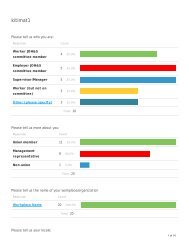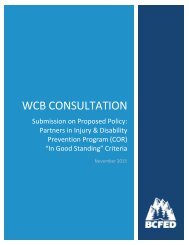KITIMAT DRAFT Report
Create successful ePaper yourself
Turn your PDF publications into a flip-book with our unique Google optimized e-Paper software.
Figure 7<br />
Elimination of Attitudinal Barriers<br />
Attribute #5 - Key Research:<br />
Research evidence has shown that it is behaviours in the workplace that are associated with good<br />
return-to-work outcomes. (Intracorp – 2002)<br />
Most thought that the greatest barriers to return to work were workers` fears about injuries and<br />
unsupportive supervisors or co-workers. (Guzman, Yassi, Cooper, Khohar – 2002)<br />
If others are disadvantaged by the RTW plan, this can lead to resentment towards the returning<br />
worker rather than cooperation with the RTW process. The injured worker may have to deal with<br />
co-workers who resent having to take over some of his or her work and therefore feel that the worker<br />
has managed to get an ``easier`` job (Workplace-based Return-to-Work Interventions: A Systematic<br />
Review of the Quantitative and Qualitative Literature – Institute for Work and Health - 2004)<br />
An extensive review of literatures on employment for persons with disabilities identified the following<br />
key barriers to employers recruiting and retaining persons with disabilities: Negative attitudes, false<br />
assumptions and myths and perceptions about persons with disabilities held by employers, managers<br />
and supervisors and other employees. (Recruitment and Retention of Persons with Disabilities ain<br />
British Columbia – 2004)<br />
Future research should include disability outcomes other than return to work and address attitudinal<br />
and environmental factors at home as well as factors at work. (Guzman et al – 2007)<br />
Workers’ problems with extended claims were linked to RTW policies that did not easily accommodate<br />
conflict or power imbalances among RTW parties and by social relations and processes that impeded<br />
communication about RTW situations and problems. Avenues for intervention are located in a shift<br />
to a critical lens to RTW process that addresses differences of knowledge, resources and interests<br />
among different parties. (MacEachen, Kosny, Ferrier & Chambers – 2010)<br />
<strong>DRAFT</strong><br />
In conclusion, managerial and worker participation in OHS initiatives characterizes safer workplaces.<br />
Also, general concern of management towards OHS—illustrated by both attitudes and concrete<br />
actions—is also associated with lower injury rates. (Geldart et al – 2010)<br />
Situational assessment<br />
District of Kitimat<br />
29





